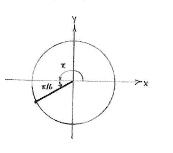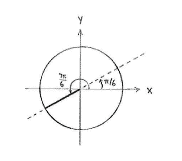Lösung 4.2:4e
Aus Online Mathematik Brückenkurs 1
(Unterschied zwischen Versionen)
K |
|||
| Zeile 1: | Zeile 1: | ||
| - | If we write the angle | + | If we write the angle <math>\frac{7\pi}{6}</math> as |
| - | <math>\frac{7\pi }{6}</math> | + | |
| - | as | + | |
| - | <math>\frac{7\pi }{6}=\frac{6\pi +\pi }{6}=\pi +\frac{\pi }{6}</math> | + | {{Displayed math||<math>\frac{7\pi}{6} = \frac{6\pi+\pi}{6} = \pi + \frac{\pi }{6}</math>}} |
| - | we see that the angle | + | we see that the angle <math>7\pi/6</math> on the unit circle is in the third quadrant and makes an angle <math>\pi/6</math> with the negative ''x''-axis. |
| - | <math> | + | |
| - | on | + | |
| - | <math> | + | |
| - | with the negative | + | |
| - | + | ||
| - | -axis. | + | |
[[Image:4_2_4_e1.gif|center]] | [[Image:4_2_4_e1.gif|center]] | ||
| - | Geometrically, | + | Geometrically, <math>\tan (7\pi/6)</math> is defined as the slope of the line having an angle <math>7\pi/6</math> and, because this line has the same slope as the line having angle <math>\pi/6</math>, we have that |
| - | <math>\tan | + | |
| - | is defined as the | + | |
| - | <math> | + | |
| - | and, because this line has the same slope as the line having angle | + | |
| - | <math> | + | |
| - | + | ||
| - | + | ||
| + | {{Displayed math||<math>\tan\frac{7\pi}{6} = \tan\frac{\pi}{6} = \frac{\sin\dfrac{\pi }{6}}{\cos\dfrac{\pi }{6}} = \frac{\dfrac{1}{2}}{\dfrac{\sqrt{3}}{2}} = \frac{1}{\sqrt{3}}\,\textrm{.}</math>}} | ||
[[Image:4_2_4_e2.gif|center]] | [[Image:4_2_4_e2.gif|center]] | ||
Version vom 10:44, 9. Okt. 2008
If we write the angle \displaystyle \frac{7\pi}{6} as
we see that the angle \displaystyle 7\pi/6 on the unit circle is in the third quadrant and makes an angle \displaystyle \pi/6 with the negative x-axis.
Geometrically, \displaystyle \tan (7\pi/6) is defined as the slope of the line having an angle \displaystyle 7\pi/6 and, because this line has the same slope as the line having angle \displaystyle \pi/6, we have that


